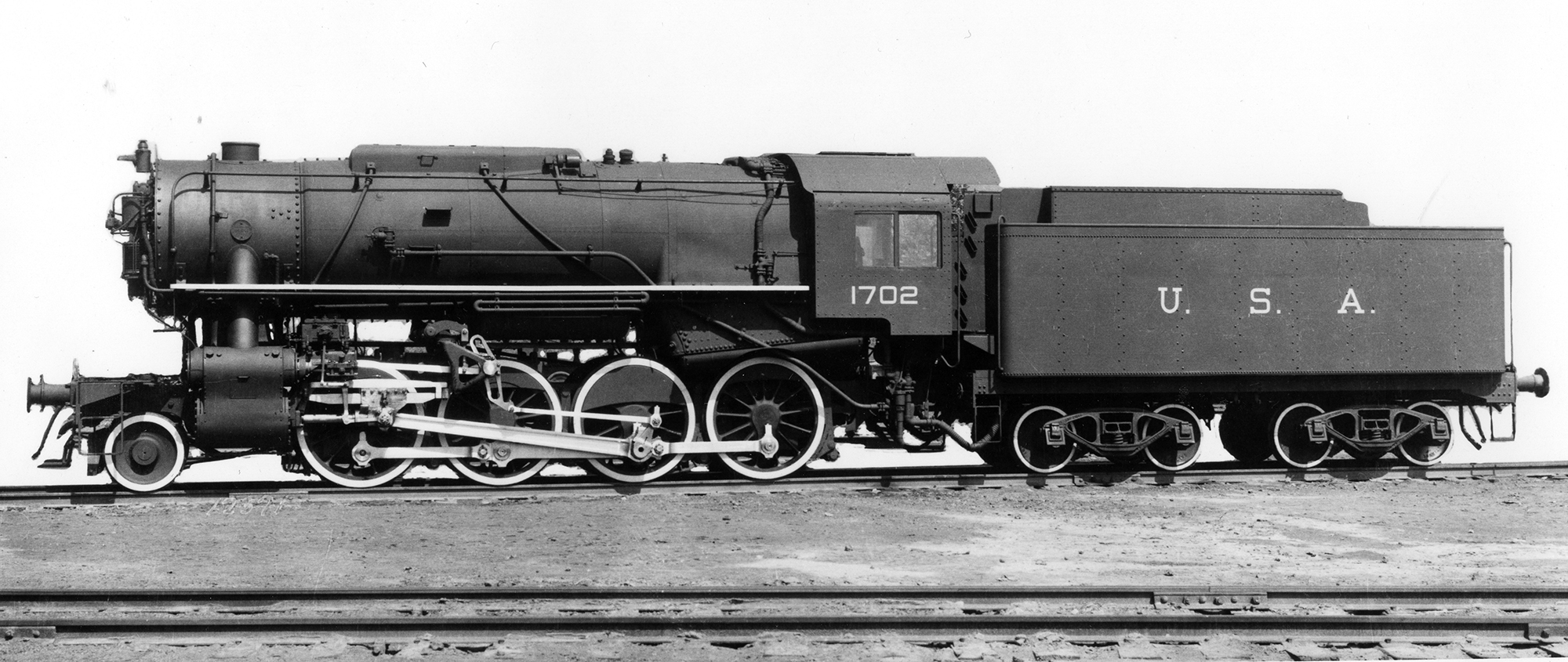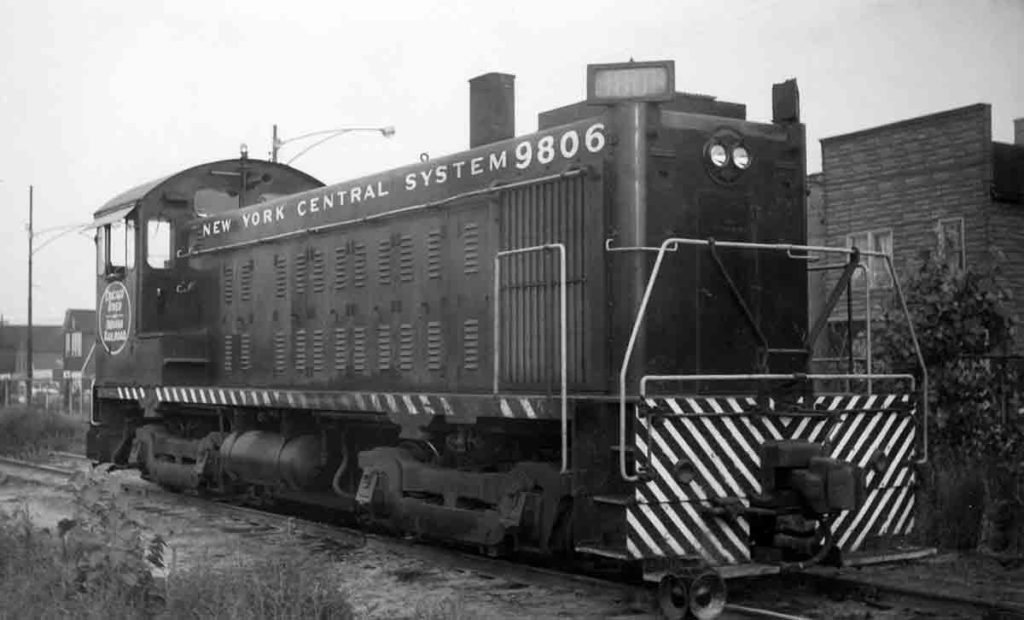A YouTube channel I subscribe to that covers a lot of the PA operations did an excellent video of R&N #425 on the most recent fall excursion.
A YouTube channel I subscribe to that covers a lot of the PA operations did an excellent video of R&N #425 on the most recent fall excursion.
In reply to Pete Gossett (Forum Supporter) :
Definitely one of the loudest and prettiest engines out there. The #611 when I saw it wasn't even as loud as #425, although part of that might have been that #611 really wasn't working that hard at Strasburg. #611's Hancock 3-chime whistle you didn't hear as much as feel though. It was this low-resonance that you felt in your chest cavity.
I know there are those (GM&O/GM&N fans particularly) who would like to see #425 reverted to the original high headlight and basic black paint, but I much prefer the post-2015 facelift appearance, with the DL&W Pocono headlamp and medium blue paint. Its a good look and it makes her stand out from the crowd.
One of the railfan mags asked R&N management if they were going to paint Reading #2102 blue as well, and they laughed and said no, there would be no blue Reading T-1. They did say they have a special livery in mind though. My guess is, probably the Reading Iron Horse Rambles livery, with the yellow lettering and handrails and trim
R&N #425 has been heavily face-lifted over the years, but the most drastically-altered is still the #1702 at Great Smokey Mountains Railroad.
The #1702 was built at Eddystone by Baldwin in 1942 for the US Army Transportation Corp as one of the S-160 2-8-0s. It was intended to be sent to Europe, and so was equipped with European link & hook couplers and buffers. It instead remained in the US and was sent to Fort Bragg, where it was converted to the usual Janney knuckle-style couplers. It had that odd S-160 look, with the boiler appearing perched high and set back from the front of the engine, firebox tucked up over the rear driver, a single air compressor hung on the smokebox front, high-mounted headlight, a low and flat combination sand and steam dome, and a stubby 4-axle tender.

After her Army career was over, the #1702 was sold off to the Warren & Saline River Railroad, an Arkansas shortline. There it was converted to an oil-burner. In 1964, it was purchased by the Reader Railroad, another Arkansas shortline that ran served oil fields in the area and operated steam locomotives until 1973. The #1702 was the "big" engine on the Reader. At the Reader, it was "Americanized" to have a more conventional appearance. Employees went down to Mexico to collect some parts, and employees of the St. Louis Southwestern (the visored headlamp with angled numberboards), Texas & Pacific (the air pumps on the front deck with angled metal shields), and Union Pacific donated parts that they had salvaged off deadlines to give it a facelift. Reader also purchased the tender from a Rock Island Mikado, #2662, and installed it behind the Consolidation.

After the Reader shut down, the #1702 sat in storage until 1985, when it went out to the Fremont & Elkhorn Valley in Nebraska where it operated for a few years, with the only change being new lettering. Then, in 1991 it was sold to the Great Smokey Mountain Railroad in Bryson City, NC. It received further cosmetic alterations in the form of a taller smoke stack and a cab that was made wider along with filling in the notches behind the rear driver. It's a more American-looking engine these days, but the weird dome, the stack that's significantly taller than the cab, and the just odd proportions of the boiler make it still a strange-looking machine. You can tell at first glance that there just is something off about the engine.

NickD said:A rarity at Maybrook: one of the New Haven's ten Lima-Hamilton 1200hp end-cab switchers.
Also, worth mentioning that this September marked the 70th anniversary of Lima's demise. In September of 1951 it was merged into Baldwin Locomotive Works and essentially ceased to exist. The entire Lima lineup of locomotives and the Hamilton engine (by that point, it was Lima-Hamilton Corporation) were discarded by Baldwin in favor of Baldwin's lineup and the De La Vergne engine that they used.
Lima's response to the diesel era was an almost ridiculous blindness to what was happening. Lima had long lead advancements in the steam era, and when the diesel, or oil-electrics as they were called, first hit the scene, Lima was fully under the impression they were a flash in the pan. Baldwin and Alco felt similarly (Baldwin in fact stated that steam locomotives would remain primary motive power until 1980) but still delved into the market a little. They had already both built electric locomotives, and they built some early self-propelled cars and switchers and box-cabs through various partners like GE and Ingersoll-Rand and Westinghouse. Lima avoided that all. They never turned out any electric locomotives, and before WWII restricted the Big Three to producing steam locomotives, Lima had avoided tinkering with any other forms of propulsion.
Even after WWII, as it became painfully obvious that the era of steam power was done and Baldwin and Alco threw themselves headlong into the diesel market, Lima continued to tinker with steam. In 1946, Fairbanks-Morse approached Lima with an offer for a partnership. F-M's deal with GE would run out in 1949 (F-M had no facilities of their own to construct locomotives and was borrowing GE's Erie, PA plant, hence the reason their first cab units were called Erie-Builts), so they wanted to team up with Lima. Lima would provide the construction facilities, F-M would provide the engines, and Westinghouse or GE would have supplied the electrical gear. Lima turned them down. Then in 1947, Lima quietly purchased General Machinery Corporation in Hamilton, Ohio and changed the name to Lima-Hamilton Corporation. When Alco was turning out their last steam locomotives in 1948, the seven Berkshires for the P&LE, Alco had already converted their tender shop to a diesel line and so had to farm out their tender construction to Lima. As late as 1949, Lima was trying to sell a 4-8-6 locomotive design with a double Belpaire boiler to anyone who was interested. Of course, no one was and none were built.
Two years after their buyout of General Machinery Corporation, Lima-Hamilton's first diesel locomotive rolled out of the former tender shop. Coincidentally, it was the same day they completed the constrcution of their last steam locomotive, Nickel Plate S-3 Berkshire #779. The first diesel was a simple end-cab switcher with a Hamilton diesel engine, which was the whole reason that Lima had purchased General Machinery Corp, so that they didn't have to develop their own diesel prime mover. The Hamilton engine was originally used in marine and stationary generator applications and was a 4-stroke, turbocharged engine with an 8 1/2"x12" and a rated engine speed of 950-rpm, and was available in both inline-6 and inline-8 configurations. The Hamilton engine was rather innovative for the time, featuring an intercooler before all their competitors, along with dry-sump lubrication, but it was also fairly crude, not well-adapted for railroad use, and prone to producing large amounts of smoke even at idle. The Hamilton engines were backed by Westinghouse generators and Westinghouse traction motors. Styling was very straight-edged and no-frills and looked almost like a cross between the earlier Also S1s and the later Baldwin S12s.

Equipped with the 8-cylinder version and rated at 1000hp, it did a quick demonstrator tour before being sold to the Toledo, Peoria & Western. They sold another 37 of the 1000hp end cab switchers over 1949, all to railroads that neighbored the plant, like the New York Central, B&O, NKP, Wabash and Erie, as well as three to Armco Steel. The 1000hp version was replaced in 1950 with a 1200hp version that was created by simply turning up the fuel racks on the engine. It nearly doubled sales of the 1000hp model, with 69 sold, again to largely the same customers, with Terminal Railroad of St. Louis and the New Haven the only new customers.
Alongside the 1000hp version in 1949, there was also a 6-cylinder 750hp model, of which they sold a whopping 6, all to Cincinatti Union Terminal. For 1950, they adjusted the fuel racks to bump the horsepower rating up to 800hp. This sold almost four times the amount of units, although that only works out to 23 units, 2 to the Rock Island and 21 to the NYC.

In 1950, Lima-Hamilton also introduced a 1200hp road switcher. These were basically the 1200hp end-cab switcher with an extended frame, a short hood to contain a steam generator and gearing for general service. The cab shape and the hood heights were similar to an Alco RS, but the squared-off hood design was similar to a Baldwin AS road switcher. The New York Central was the sole buyer, purchasing 16 of them for use on passenger service on the Boston & Albany. They didn't pan out in this service and were demoted to light local freight service in Ohio and New Jersey. The Central also had an outstanding order for another 17 when Lima-Hamilton merged into Baldwin.

Lima-Hamilton also catalogued a massive 6-axle, twin-engined center cab transfer locomotive in 1950. The sole buyer was Pennsy, purchasing 23 of these monsters. They used the running gear from a 1200hp end-cab switcher mounted on each end of the locomotive, and so Lima-Hamilton rated them at 2400hp. Pennsy though rated them at 2500hp, and so Lima ended up rating them to 2500hp as well to avoid any confusion, despite them still having two 1200hp engines.

Lima-Hamilton had a number of other models planned for their lineup, including an 800hp B-B road switcher, a 1600hp center cab C-C road switcher/transfer unit, a 1600hp switcher combo that was two of the 800hp switchers semi-permanently coupled back-to-back, and a 2400hp switcher combo that was two of the 1200hp switchers semi-permanently coupled back-to-back. But, by 1951, Lima-Hamilton was aware that selling 174 total units in 28 months was just not going to cut it. They entered conversations with Baldwin Locomotive Works, and in September of 1951 the merger went through. Baldwin though wasn't interested in Lima-Hamilton's line of locomotives, they were more interested in the highway construction equipment part of the business that was from General Machinery Corporation. When the merger went through, Lima-Hamilton's entire line of locomotives and the Hamilton engine were deposited in the trashbin, since even Baldwin handily outsold Lima-Hamilton (in two years, Baldwin sold 502 of their 1000hp DS-4-4-1000 switchers, versus 174 L-H sales of all models) and the Hamilton engine wasn't any more advanced or reliable than Baldwin's De La Vergne engines. The final Lima-Hamilton's actually rolled out of the factory post-merger, meaning they were orphans before they were delivered, and even the earliest built units were orphans at 28 months old.
As orphan units with only two years of production and no prime mover parts supply, the Lima-Hamiltons were quickly culled from the herd. Not helping their survival rate was that most of them were purchased by Class Is, so they were run into the ground and sent to scrapyard. The big 2400hp transfer units hung around on the PRR until the mid '60s, and a few of them were still running in the Penn Central era before they were all retired in 1971. A few of the NYC's 1200hp road switchers were repowered with EMD 567 V12s and also lasted into the Penn Central era. Today, only four Lima-Hamilton diesels survive. Whitewater Valley has three, an ex-Cincinatti Union Terminal 750hp switcher, an ex-ARMCO Steel 1000hp switcher, and an ex-B&O/exx-ARMCO Steel 1200hp switcher, and Illinois Railway Museum has the fourth, another ex-ARMCO Steel 1200hp switcher. Only the ex-CUT unit at Whitewater Valley is currently operational, although Whitewater Valley hopes to get the 1000hp unit up and running as well.

Lima's failure can be attributed to a number of causes. The first is just waiting so long to even dip their toes into the diesel market. By that point, EMD, Alco, Baldwin and F-M were all fairly entrenched, and that's not counting GE, Whitcomb and Plymouth, who were also all cranking out switchers like there was no tomorrow. There wasn't really room for Lima. There was also the fact that there was never really a justification to purchase from Lima. Their locomotives didn't do anything that their competitors didn't, they completely lacked in innovation, ironic because Lima had always been the innovator. The styling was even minimalistic and lacking in any sort of flair. And Lima fell victim to what really doomed Baldwin and Alco: poor customer support. The Hamilton engine really wasn't that much more unreliable compared to Alco 244s or Baldwin 608s, and it was less complicated than a Fairbanks-Morse, but when one broke, getting the replacement parts was difficult and time-consuming, while EMD was known to send a spare engine along with every ten locomotives built and was on top of customer service.
In reply to NickD :
Speaking of F-M, we toured the USS Drum today & I took a few pics of its engines. I'm not sure how much, if anything, it shared with their locomotive engines though?





In reply to Pete Gossett (Forum Supporter) :
That would be the exact same engine used in an H-16-44, H-16-66, or a CFA-16-5. They all used the 1600hp 38D8 1/8 engine. Also, pretty similar to the engine in an H-15-44. I think the 1600hp variant was the same as the 1500hp version, just with the fuel turned up. The Fairbanks-Morse engine was terrific in marine use, and was the preferred power on US submarines, so it seemed like they would work pretty well in railroad usage. And they were well-liked for their power and smoothness, but the rough-and-tumble environment, cooling woes (on a ship they have the whole ocean to cool them, on a locomotive they only have the water in the radiator), poor maintenance and just a general lack of understanding by maintenance personnel because they were so different doomed them. Too bad, because when properly maintained, they could be reliable runners. Southern Pacific assigned all their F-Ms to one division, so they had a crew that knew the ins-and-outs and they kept their big H-24-66 Train Masters humming along in commuter service into the '70s. Tennessee Valley Authority had an H-16-66 "Baby Train Master" that ran into the early 2000s.
Part of why there are so few preserved F-M locomotives is because the engines were so vaunted in maritime circles, that lots of shipyards would snap up retired F-M locomotives, yank the engines out for installation in tugboats and ships, and then scrap the rest.
PRR was so impressed with their early F-M locomotives, that they were the largest purchaser of F-M engines. Also, early on, after their first experiences with F-M engines, they contacted Baldwin and told them that if they would develop a similar opposed-piston engine, PRR would buy every one they could get. Since PRR had bought steam locomotives almost exclusively from Baldwin, Baldwin knew PRR would be a good customer and had their engine subsidiary De La Vergne begin a crash course on developing an opposed-piston engine. De La Vergne spent years on it, ignoring development on their existing engine lineup, and never got it to work. By that point their 608/808 locomotive engines were outpaced by the competition, since they were maxed-out at 1600hp, and all their competitors were cranking out 2000-2400hp, contributing to Baldwin's downfall. Also, even if De La Vergne had been able to get their opposed piston engine to work, by that point they were beginning to lose their luster.
Also pretty funny is that after Bombardier quickly entered and exited the railroad business using what was left of Alco/MLW, they sold off the Alco 251 engine rights to... Fairbanks-Morse. So, now you purchase replacement 251 parts from Fairbanks-Morse, former competitor to Alco.
In reply to Pete Gossett (Forum Supporter) :
I would also hazard a guess at Fairbanks-Morse's close relationship with the US Navy is also why lots of US Army bases had Fairbanks-Morse H-12-44 switchers for the on-base railroads. Of the surviving 25 H-12-44s, ten of them are ex-US Army. The Rochester & Genesee Valley Railroad Museum here in NY has one of the ex-Army units, #1843. What's neat about the #1843 is that it was used at Seneca Army Depot, which is now a big autocross site for the local regions and hosts an SCCA National Tour event every year as well.

Two of the SP's big F-M H-24-66s with fifteen bi-level commuter coaches for the big Cal-Stanford football game at Palo Alto.

An SP H-24-66 in "Black Widow" livery, along with an Alco PA for subsidiary Texas & New Orleans, and a steam generator-equipped GP7

In reply to NickD :
I would just like to jump in and say that I find your knowledge on this topic incredible and admirable.
That is all.
Pete Gossett (Forum Supporter) said:In reply to NickD :
I wonder if any US military basses still have their own locomotives?
https://www.volpe.dot.gov/infrastructure-systems-and-technology/infrastructure-engineering-and-deployment/modernizing-rail
One of the Missouri-Illinois Railroad's picturesque little Consolidations pulls a load of hopper cars off their car ferry Ste. Genevieve. The Mike-n-Ike, as it was nicknamed, ran this car float operation across the Mississippi until 1961.

This weekend was the NY state model train fair in Syracuse, NY. I didn't take many pictures, but this one got a good chuckle out of me. Its a scale model of the 10'9" CSX bridge over the Onondaga Lake Parkway that gets clobbered like every 6 months.

The CNY NRHS also has a couple of full-size pieces on display at the state fairgrounds, that include an Amtrak-painted GG1 (I think its the only GG1 on display not in PRR colors), a very nice wooden NYC caboose, a GE side-rod 45-tonner from Crucible Steel, and a bunch of passenger cars.



NickD said:This weekend was the NY state model train fair in Syracuse, NY. I didn't take many pictures, but this one got a good chuckle out of me. Its a scale model of the 10'9" CSX bridge over the Onondaga Lake Parkway that gets clobbered like every 6 months.
LOL, great minds think alike. From the layout I'm building for my son:

kazoospec said:NickD said:This weekend was the NY state model train fair in Syracuse, NY. I didn't take many pictures, but this one got a good chuckle out of me. Its a scale model of the 10'9" CSX bridge over the Onondaga Lake Parkway that gets clobbered like every 6 months.
LOL, great minds think alike. From the layout I'm building for my son:
Someone I'm friends with who has the inside scoop on a lot of the Syracuse politics said that the city asked CSX to raise the height of the bridge over the parkway, and the CSX rep pretty much laughed in their face. The good folks of Syracuse apparently didn't understand that to raise the height of a railroad bridge a foot or so requires altering the roadbed miles in either direction.
The real issues is that segment of NY-370, called the Onondaga Lake Parkway, is used in a way that it was never intended. When they extended that stretch of NY-370 over the old routing of NY-57, the plan was for it to be a low-speed scenic drive along the shore of Onondaga Lake. But somewhere along the line, they changed it to four lanes and upped the speeds to 55mph and then all these buses and tractor trailers started using it to avoid going through Syracuse on NY-690. And then they started plowing into that old NYC bridge, which was part of the St. Lawrence Subdivision, formerly the Rome, Watertown & Ogdensburg.
They've got Low Bridge signs and all sorts of flashing warning lights miles out in either direction of that bridge and the lower truss is painted flourescent orange, and all commercial traffic is supposed to be banned from NY-370, but every year someone manages to plow a cube van or tractor trailer into it. NYC certainly built that bridge strong when they constructed it in '58, because it has taken a pounding. It even had a double-decker Mega Bus slam into it over a decade ago.
Taken from a Facebook group I'm part of, what appears to be a Chessie diesel with WWII-style victory markings. Clearly this unit had a few grade crossing incidents. I wonder if the outlines are supposed to be of the exact vehicles it encountered, because it looks like it has hit 3 PT Cruisers and 2 VW Beetles.

You'll need to log in to post.